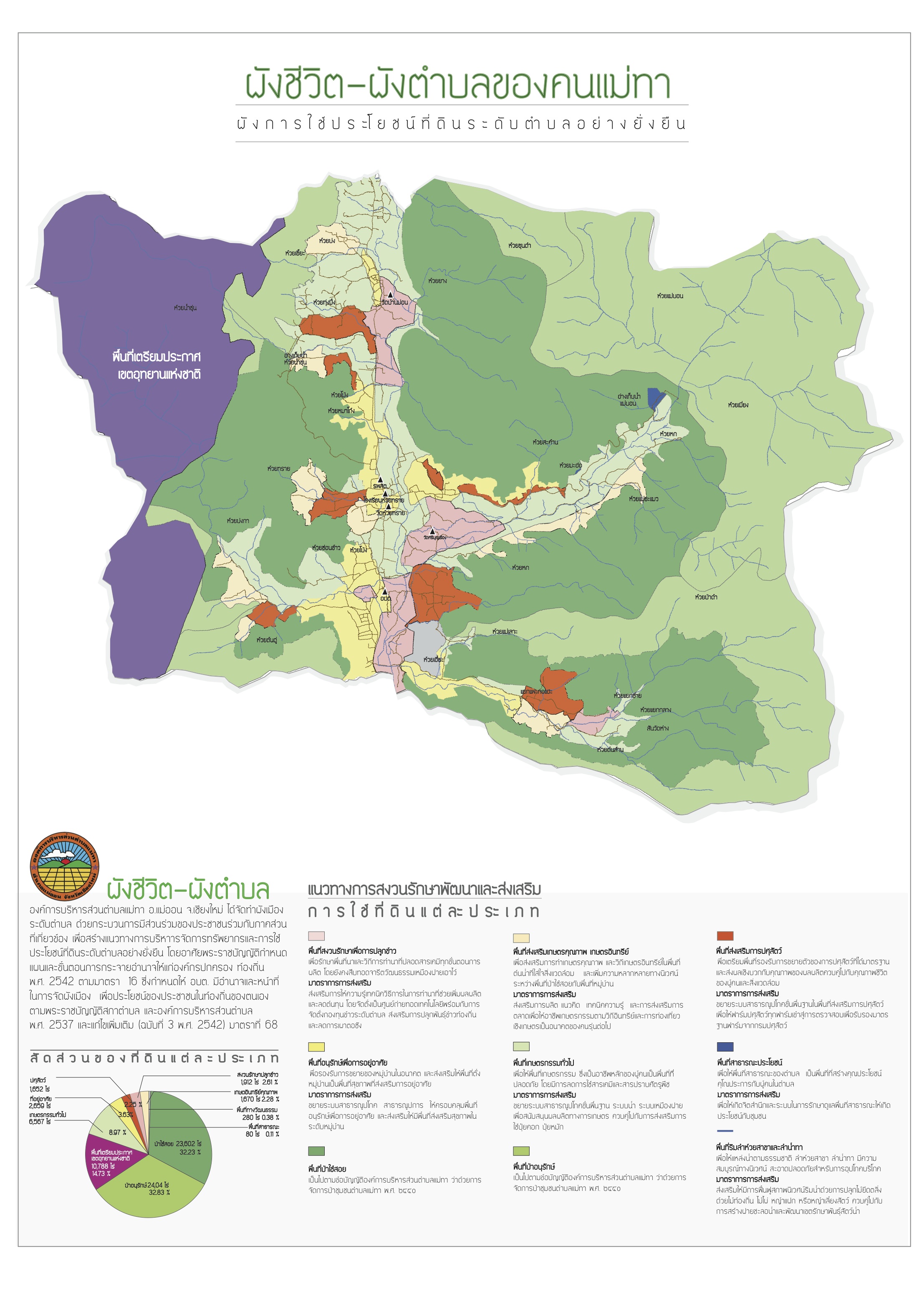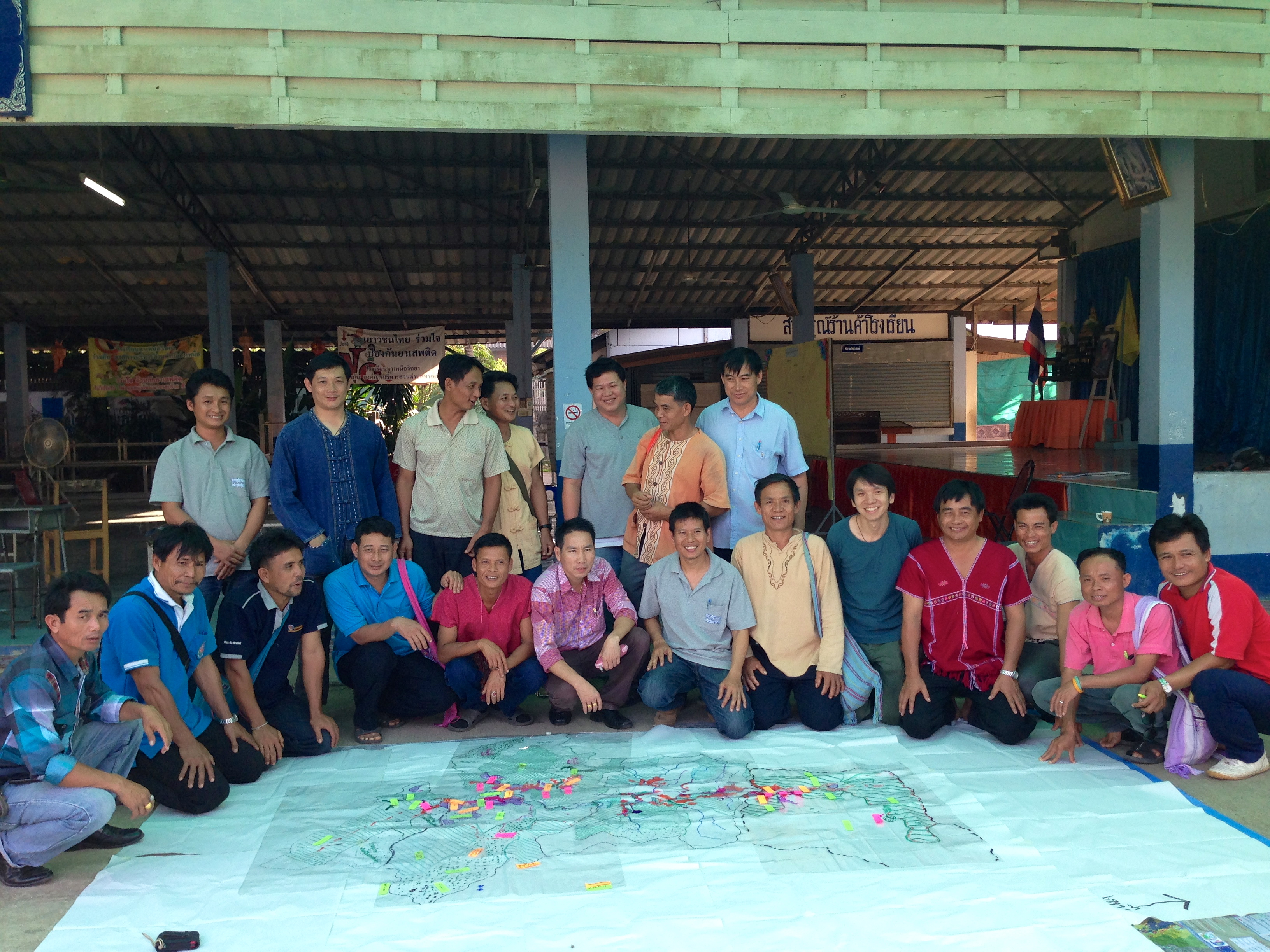 actions
actions
Land policy reformation through participatory planning in Mae Tha, ChiangMai
A decade ago traditional Thai farmers were being subjected to mass relocation off of National Forest Department land. To advocate the right to live on their ancestors land, the ‘Union of Northern Farmers’ was formed. The Union fought for a Communal Land Forest Act and used open-access technology such as GIS to demarcate boundaries. Today Thailand’s native forests and traditional rural agriculture practices are under a different threat as corporate food industries are forcing farmers and landscapes into contract farming and mono-cropping. Advocacy around The Communal Land Forest Act has reawakened, but the National Forest Department declared that “a Community Forest can not be approved by the national institution because the government doesn’t believe that people and communities can manage/protect the national forest”.
The “Tambon” (sub-district) was established in 1999 as the foundational unit of the decentralized government, overseeing sub-district planning. Mae-Tha sub-district in Northern Thailand is populated by farmers, however land-use regulations informed by provincial level land-use maps remain entirely green, a forest zone, with a small yellow dot representing village. The Tambon Administrative Office (TAO) coordinates the input of land ordinance by local people, but to date it has not been proactive in land-use planning, and practices of participatory ordinance have not been used to aid issues of land insecurity.
KonJaiBaan Studio, a group of community architects based in northern Thailand, together with the Mae-Tha Tambon Administrative Organisation (TAO) in Chiang Mai province have initiated ‘The Livelihood Plan, and Tambon District Planning of Mae-Tha subdistrict’, involving local people from seven villages to show how protection of the national forest can be performed simultaneously with management and preservation of agricultural practices.
Local ordinance is a means to control, conserve, and direct future land use, but planners can never know how to confidently control people’s lives. National forest land is also people’s everyday lived space.
Sub-district participatory natural resource management provides a democratic space for rural people to leverage their agricultural activities in the management of their indigenous land in the preserved forest zone. As a collaborative process between planners, administrators, and local people, it lets communities become agents of their own future and protectors of the environment.
The project integrates GIS data collected by the Communal Land Forest movement in 2000s, statistical and research data with a combination of other qualitative and quantitative data collected from participatory 3-D mapping and focus group discussions. Planners tend to use GIS data only to tell the slope, quality of soil, or quantity of water, but by involving local people in the process of GIS data collection, a lot of additional social and ecological information was gathered and woven into the model.
The pilot rural spatial planning between CODI’s rural Baan Mankong programme and Mae Tha sub-district demonstrated to the forest ministry how essential multi-stakeholder participation is in developing a comprehensive land-use plan for sustainable rural development in the area. In 2014, Mae Tha subdistrict received an important award from the Ministry of Interior regarding this project, on the innovative use of its role to solve community problems of land security, and in February 2015 this form of land use planning and local ordinance will become sub-district law. The pioneering move is the requirement of people’s participation, tacit knowledge and local wisdom into the integration of TAO’s annual plan, spatial planning, fiscal planning and local legislation. | Tee Boonmahathanakorn
For more information, contact Tee at architect_once@hotmail.com
The “Tambon” (sub-district) was established in 1999 as the foundational unit of the decentralized government, overseeing sub-district planning. Mae-Tha sub-district in Northern Thailand is populated by farmers, however land-use regulations informed by provincial level land-use maps remain entirely green, a forest zone, with a small yellow dot representing village. The Tambon Administrative Office (TAO) coordinates the input of land ordinance by local people, but to date it has not been proactive in land-use planning, and practices of participatory ordinance have not been used to aid issues of land insecurity.
KonJaiBaan Studio, a group of community architects based in northern Thailand, together with the Mae-Tha Tambon Administrative Organisation (TAO) in Chiang Mai province have initiated ‘The Livelihood Plan, and Tambon District Planning of Mae-Tha subdistrict’, involving local people from seven villages to show how protection of the national forest can be performed simultaneously with management and preservation of agricultural practices.
Local ordinance is a means to control, conserve, and direct future land use, but planners can never know how to confidently control people’s lives. National forest land is also people’s everyday lived space.
Sub-district participatory natural resource management provides a democratic space for rural people to leverage their agricultural activities in the management of their indigenous land in the preserved forest zone. As a collaborative process between planners, administrators, and local people, it lets communities become agents of their own future and protectors of the environment.
The project integrates GIS data collected by the Communal Land Forest movement in 2000s, statistical and research data with a combination of other qualitative and quantitative data collected from participatory 3-D mapping and focus group discussions. Planners tend to use GIS data only to tell the slope, quality of soil, or quantity of water, but by involving local people in the process of GIS data collection, a lot of additional social and ecological information was gathered and woven into the model.
The pilot rural spatial planning between CODI’s rural Baan Mankong programme and Mae Tha sub-district demonstrated to the forest ministry how essential multi-stakeholder participation is in developing a comprehensive land-use plan for sustainable rural development in the area. In 2014, Mae Tha subdistrict received an important award from the Ministry of Interior regarding this project, on the innovative use of its role to solve community problems of land security, and in February 2015 this form of land use planning and local ordinance will become sub-district law. The pioneering move is the requirement of people’s participation, tacit knowledge and local wisdom into the integration of TAO’s annual plan, spatial planning, fiscal planning and local legislation. | Tee Boonmahathanakorn
For more information, contact Tee at architect_once@hotmail.com
Location:
Thailand

Team:
KonJaiBaan
Year:
2014
Land policy reformation through participatory planning in Mae Tha, ChiangMai
Land policy reformation through participatory planning in Mae Tha, ChiangMai




